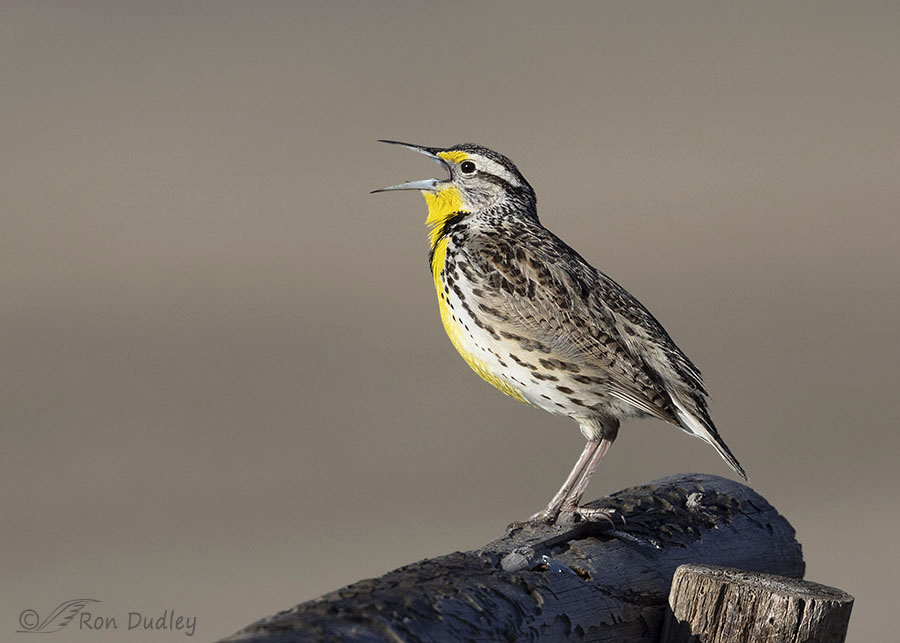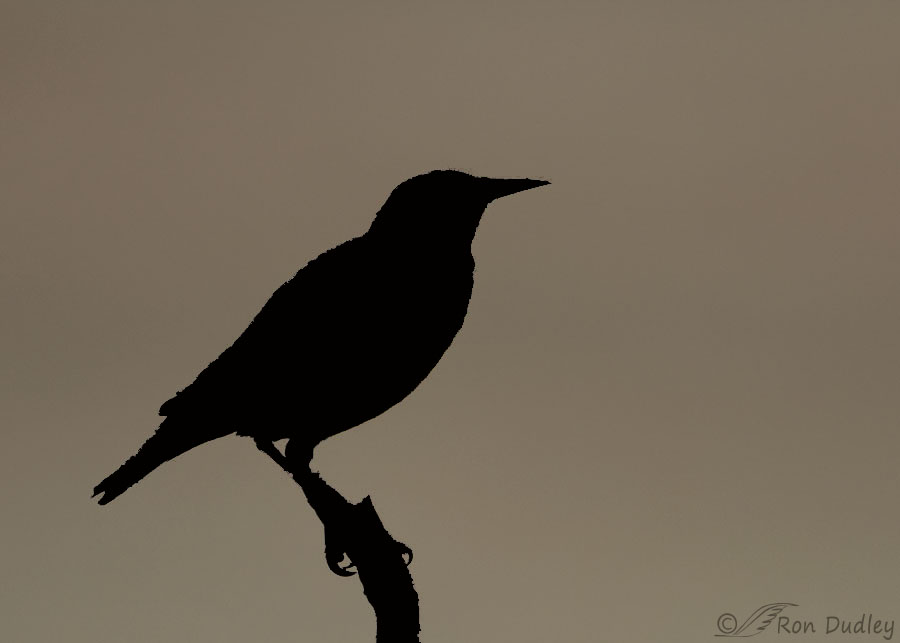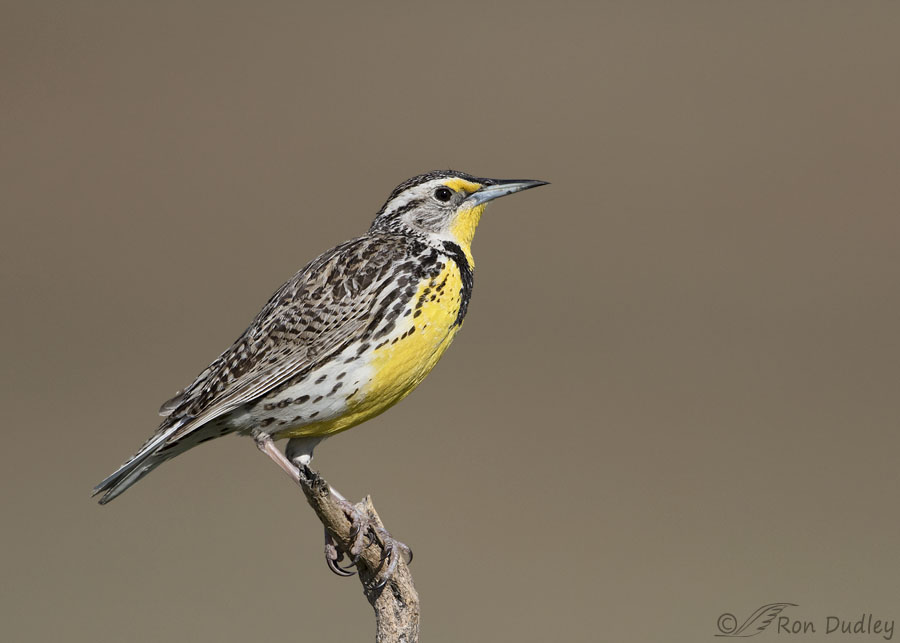How do meadowlarks learn their distinctive and complex song? And what about that curious Latin name?

1/2500, f/9, ISO 500, Canon R5, Canon EF500mm f/4L IS II USM + 1.4 tc, not baited, set up or called in
Four days ago I found this Western Meadowlark, almost certainly a male, singing his heart out atop a rustic wooden fence near Garr Ranch on Antelope Island. I took lots of photos of him but he was side lit so only a few of them had good light on his face and most of his body. Getting good light on the bird while he was in a singing pose I like is one of the reasons I take so many photos in a situation like this. Very few of them actually turn out well. Sometimes none of them do.
Meadowlarks have to learn their primary song from other meadowlarks and if it isn’t learned by the end of their first winter it’s never learned. Captive meadowlarks isolated from their own species through their first winter and then exposed to singing meadowlarks never develop meadowlark song. Instead they imitate other species they heard during that critical early period (Red-winged Blackbirds for example) and they retain those songs throughout life.
I have difficulty remembering the scientific (Latin) names of some species but others strike a chord with me that somehow makes them much easier to recall. Scientific names such as Buteo regalis (Ferruginous Hawk) and Tyrannus verticalis (Western Kingbird) come to mind easily for me. And no one with a juvenile sense of humor like mine could forget Turdus migratorius (American Robin). But I have to look up Cistothorus palustris (Marsh Wren) every time I post a photo of that species.
For me the scientific name of the Western Meadowlark, Sturnella neglecta, is one of the easy ones, probably because of the curious aspects of neglecta.. Even though Lewis and Clark were familiar with the Western Meadowlark, the species was subsequently overlooked and mostly ignored by later early naturalists so in 1844 John James Audubon assigned neglecta as their species name.
The genus name Sturnella is a diminutive of the Latin sturnus meaning “starling” and that makes sense.

The body and bill shapes of meadowlarks and starlings are very similar but this is a silhouette of a…

meadowlark.
I’m rambling again. Time to quit.
Ron


Late to the party today. He looks like he is singing his little heart out. Whatchamacallits are such cheery birds. 😉
That’s a curious fact about the singing. My brain is now trying to turn it into a lesson about fitting in.
Good luck with that.
Touchingly fascinating Ron. A wonderful and interesting insight into avian systematics that makes the subject actually interesting! Thank you.
Much appreciated, Michael. That’s one of the challenges of a teacher – to make seemingly mundane things at least a little more interesting.
Sorry, more rambling – if you are seeing fewer western meadowlarks, then there’s more chance a youngster won’t learn the song in the critical first summer. Wrong song equals no mate, equals no breeding, equals no new western meadowlarks, and so on?
Sounds like a vicious circle doesn’t it Carolyn.
For many years I collected the names that have been used for North American birds including as many local and regional names as I could find. I finally found over 10,000 names, including some very colorful names that local hunters used. Finding the origin of the names was not always easy or even possible in some cases. For meadowlarks, it was my understanding that Sturnella meant “star-like” because in flight the bird was shaped like a star with the wingtips, beak and tail forming the star’s points. Starling, the common name, has the same origin. So I always understood that the two birds got their names for the same reason but one wasn’t named for the other. Finding the names was a fun search while I did it.
Dan, regarding the meaning of “starling” I just quoted Wikipedia which said “The name Sturnella is a diminutive of the Latin sturnus meaning “starling”.”
While I was searching names I often came across things like this with two or ore explanations for the same name. Sometimes I could never be sure which explanation was correct. There was a book on names published in the 1970s but I found so many things in it I knew were wrong that I stopped relying on it as an authority. It was a fun search but not always a sure thing.
I guess that’s one of the downsides of the modern era, Dan – we can get instant answers but they can be less accurate then they should be. And then those inaccuracies get passed along the chain.
Fascinating! April has a great point – needing to play meadowlark songs during rehab. When we were in NJ, the cardinals learned different songs, depending on who they were exposed to, and I’ve read that white-throated sparrows are changing their songs, apparently after exposure to WTS in western Canada. Thanks so much for this info, and for the Latin names. Two Turdus migratorius (what’s the plural?) showed up in our yard today – it’s a great name, but I think I’ll stick with “Robin”:)
Ha, I think I’ll stick with “robin” too, Carolyn. Except when I’m teaching a class of teenagers – they always enjoy hearing their teacher say “Turdus”.
I did not know meadowlarks needed to hear the song the first year. I know some birds do. I guess we will have to play meadowlark songs for them in rehab. House finches raised in rehab take longer to learn their song, when we are weathering them in the mew they sound so odd picking up bits and pieces and trying out their repertoire. It has made us smile many times while listening.
“It has made us smile many times while listening.”
I’ll bet. Kinda like a human toddler trying to learn how to talk. It’s often adorable.
Beautiful photos and educational too! Thanks. Love meadowlarks but I’ve only seen the Eastern version. Can’t wait to get out west again.
Thanks, Joanne. We still have quite a few of them but the way things are going don’t wait too long.
I often wish that I had grown up in a multilingual household. Like the Meadowlark, learning another language beyond early childhood is very difficult for most people. I have a few books on the Latin names of birds and plants and do enjoy learning the meaning and etymology of them. If birds were commonly called by their scientific names I don’t know that Haliaeetus leucocephalus would have become the national bird.
I often wonder why, when we encounter a new bird or plant or whatever, we say “what’s that?” and get so much satisfaction out of learning what it has been named, as if we have learned the something of the essence of it.
Lyle, learning new words in another language is very difficult for me. My mother was Canadian so she knew French fairly well. As a young kid she taught me these two very short and very similar sentences in French and those two were about my limit.
Ferme la bouche.
Ferme la port.
So was she telling you to stop talking or to cover your mouth depending the instance. Close the door I get, my kids left the doors open all the time.
Yup, she told me the two sentences meant “shut your mouth” and “shut the door”
Interesting column and photos, especially the silhouette of the… meadowlark. Clever way to illustrate your point.
Eastern and Western Meadowlarks are classified as different species, based on their songs. So a learned characteristic can determine the species??? That’s crazy, if true. Or are there more subtle differences that one can tell with a bird in hand that make the call just an easy way to handle birds in the bush?
I’m glad the silhouette was interesting for you, Nancy. I think their body shapes are very similar.
Fun picture and column.
Eastern Meadowlarks are classified as a different species from Western Meadowlarks, based on their songs, I think. So a learned characteristic can make a bird a different species? That’s crazy, if true! Or are there more subtle things one can tell in hand that determine the different species classification as well?
Nancy, there would be genetic differences between the two species too, and possibly behavioral differences.
I learn so much about birds from your posts and this one on Meadowlarks as well as the recent Eagle vs Ducks posts are really great reads. Thank you, and I hope you’re getting more & more adjusted to the R5. Great pick.
Good to know, Elmer. Learning the R5 is a real challenge.
Beautiful crystal sharp photos – the new camera is coming along well. Love the Meadowlarks in the spring. Very educational post Ron. Had zero knowledge about them learning the songs from others. That is very interesting. I don’t memorize or remember any of the Latin names. Getting too old to remember new things. Excellent post.
Everett, I have to use scientific names as search terms for my posts so I’m always writing them. Remembering them is another matter.
The “learning” mode you describe for the Meadowlark’s song is really fascinating……it made me quite sad to think of a young meadowlark
who couldn’t produce the glittering song of his/her cousins– but I guess
they wouldn’t miss what they never had– would that interfere with attracting
a mate or establishing a territory, do you know ?
“would that interfere with attracting a mate or establishing a territory, do you know”
I would think so, Kris – especially attracting a mate but maybe both.
Nice! Interesting that they have to learn the basic song from others and that it isn’t innate – heaven forbid one sound like a Red-winged Blackbird. 😉 Latin names are something I’ve never gotten into tho did figure out it was a good idea many years ago upon discovering there were different “names” for the same plant/animal depending on where one lived….OOPS! 😉
No meadowlarks here yet tho an “American” Robin did finally show up Monday as a B-Day present. HA! Robins in the UK are a very different bird. Talk about rambling!
“upon discovering there were different “names” for the same plant/animal depending on where one lived”
Judy, when I was teaching I used the Mountain Lion as an example of the need for Latin names. There are at least 9 regional common names for that one species of cat.
Hmm, so they learn a song via auditory imprinting during that first critical stage eh? I’ve often wondered why some mockingbirds can sing fantastic long-winded songs with catchy twirly melodies that are so very entertaining. But it’s a rare mockingbird! Not all mockingbirds have such a repertoire of melodies.
Terri, the Latin name of the Northern Mockingbird is one that I have special fondness for because it’s so darned appropriate. Mimus polyglottos means “many-tongued mimic”.